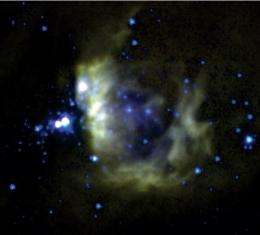Astronomers plan second look at mega star birthing grounds

(PhysOrg.com) -- Astronomers this summer will take a close look at a rare cosmic cradle for the universe's largest stars, baby bruisers that grow up to have 50 times the sun's mass.
The international team of astronomers headed by University of Florida scientist Peter Barnes used an Australian radio telescope to find the cloud of gas and dust 8,000 light years away in the Southern sky constellation Carina. The cloud is in the early stages of collapsing in on itself, offering astronomers an unusual vista on the first contractions of behemoth star birth.
"We understand some of it, but we really don't have a clear picture of what's important," Barnes said. "This should help us learn a lot more about the process."
Although our sun has far less mass than the incipient stars in the gas cloud, studying their formation could help astronomers understand how our solar system formed, Barnes said. That is because many stars the size of our sun are thought to have formed in clusters that dispersed into space over millions of years. It's possible, Barnes said, that our sun traces its origin to such a cluster, and in fact chemical anomalies on meteorites suggest that's the case.
The latest findings, which appeared in the monthly journal Notices of the Royal Astronomical Society, have spurred the team to plan a closer look with another Australian telescope in August. The team will also use the Gemini South telescope, equipped with a mid-infrared camera designed and built at UF, to observe the cloud from the telescope's location in Chile.
Stars at least 10 times the mass of our sun are rare, comprising only about 4 percent of those in the universe. Most are also at least 1,000 light years away and hard to study. It's exceptionally rare for astronomers to encounter clouds of gas and dust early in the process of collapsing into large stars because the stars tend to destroy their natal origins.
"They're rather nasty tykes," Barnes said. "They make a big mess."
The astronomers discovered the gas cloud as part of a survey of 300 large gas clouds using the Australia Telescope National Facility's 22-meter Mopra radio telescope in southeastern Australia. The telescope's world-class spectrometer allows astronomers to identify and image carbon monoxide and other molecules in large gas clouds. Even with that technology, the mega star birthing cloud was the only one of its kind among the 300 surveyed.
The cloud is also unusual in its rapid pace of collapse and the amount of dust and gas, an amount so large it eclipsed the large stars that had already coalesced inside the cloud. "It is a few light years across, and it has maybe 20,000 times the sun's mass worth of gas and dust, and most of that is participating in the collapse," Barnes said.
Provided by University of Florida

















